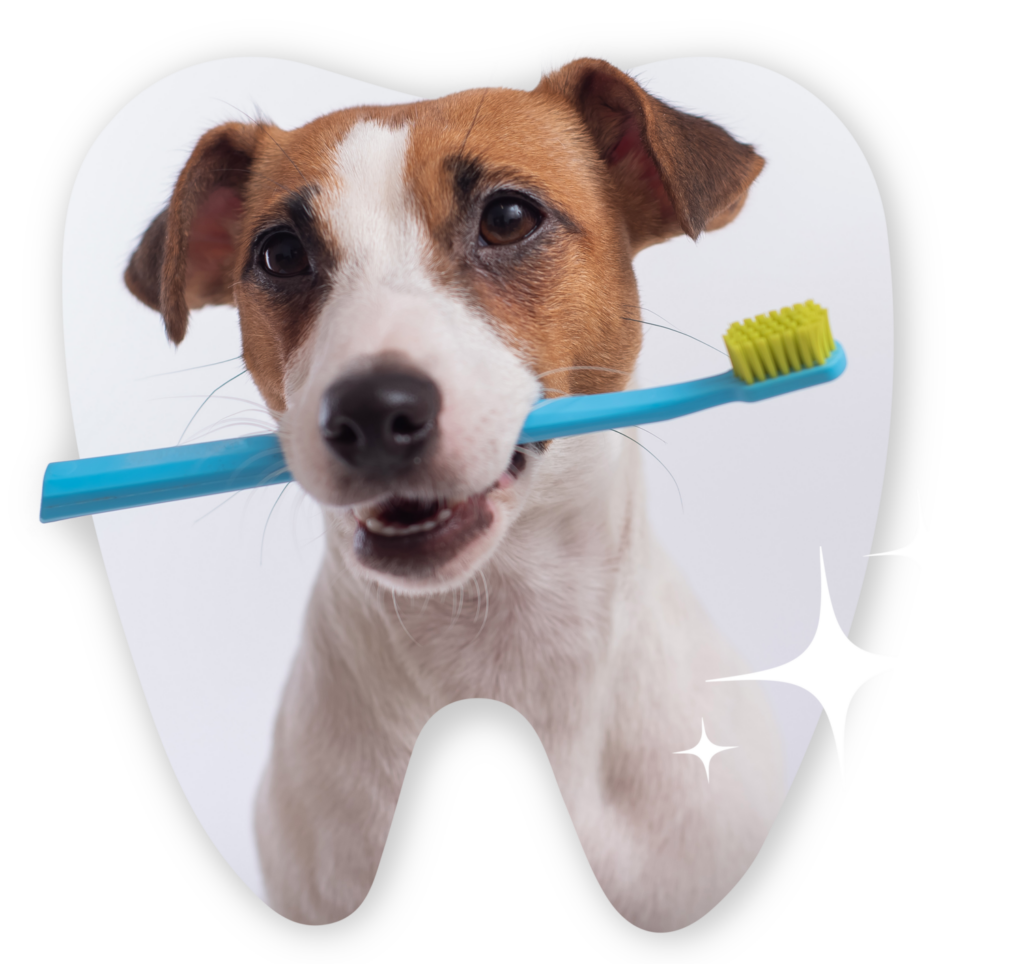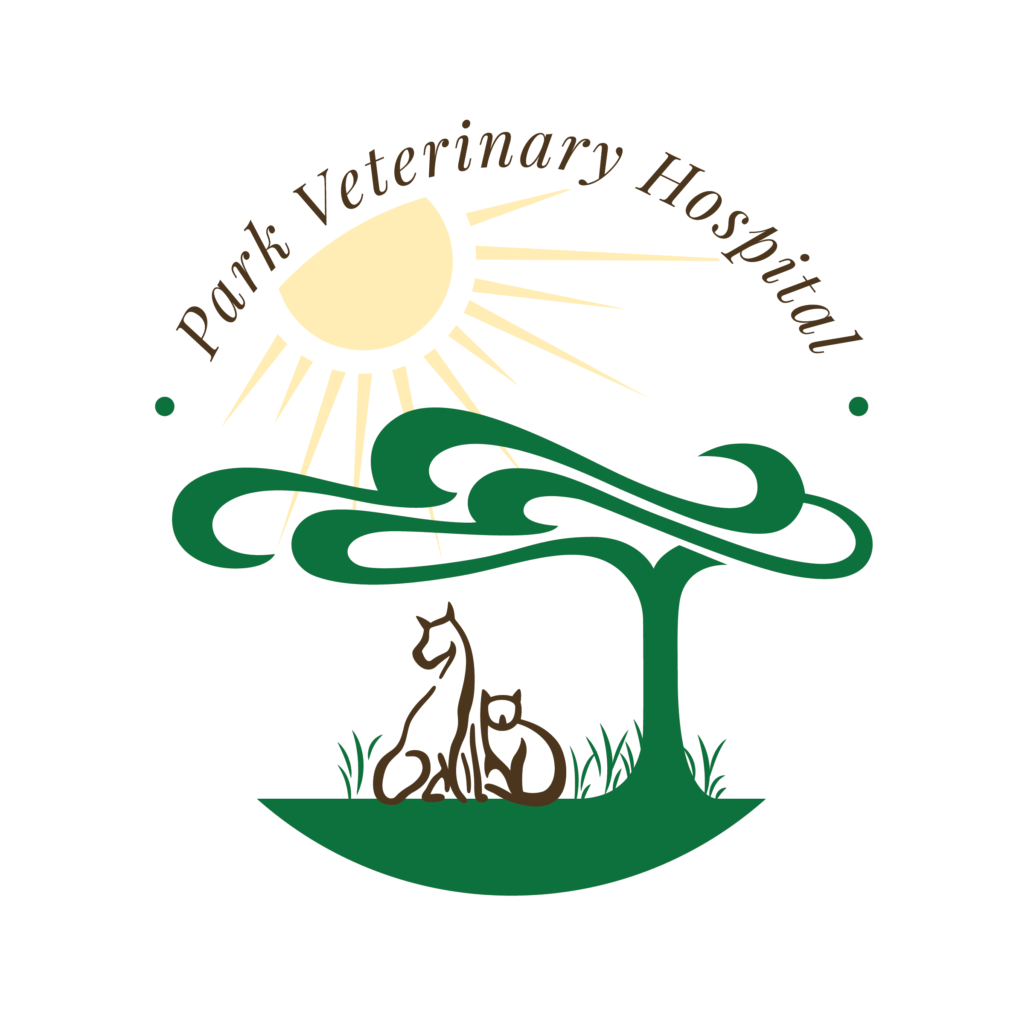Dental Days Deal
$100 off Dental Cleanings
For new and existing clients!
Call (954) 561-8387 to schedule a cleaning today!

*New and existing clients. Canine and feline only. Not valid with other offers. Not redeemable for cash. May use offer on multiple pets within the same household. Not applicable for membership or wellness plans.
Did you know dental care is one of the most neglected aspects of healthcare for pets? The American Veterinary Dental Society states that 80% of dogs and 70% of cats present symptoms of periodontal disease by the time they are three years old. Because of this, the team at Park Veterinary Hospital recommends scheduling a dog or cat teeth cleaning annually to maintain your pet’s dental health, which directly contributes to their overall well-being, too.
How to Know If Your Pet Requires Dental Care
Unfortunately, pets can’t tell us if they’re feeling any pain or discomfort, and typically will continue eating and acting normally. If you notice increased licking, altered or heavy breathing, variations in posture and sleep routines, your pet may be experiencing pain. In addition, there are a few symptoms or behaviors that may signal your pet needs dental care such as:
Bad breath
Broken, loose, or missing teeth
Discoloration or tartar build up
Excessive chewing or drooling
Reduced appetite or inability to chew
Swelling and bleeding in or around the mouth
Our Pet Dental Services near Oakland Park, FL
Unfortunately, pets can’t tell us if they’re feeling any pain or discomfort, and typically will continue eating and acting normally. If you notice increased licking, altered or heavy breathing, variations in posture and sleep routines, your pet may be experiencing pain. In addition, there are a few symptoms or behaviors that may signal your pet needs dental care such as:
- Your veterinarian will perform a physical exam on your pet and pre-anesthetic bloodwork to ensure their health prior to their teeth cleaning. Your pet will then be placed under anesthesia to allow our team to perform a more thorough examination and cleaning.
- Our professionally trained team will monitor your pet’s vitals including blood pressure, heart rate and temperature during the procedure to keep your pet safe.
- Because many oral problems can be easily missed, we recommend full mouth dental X-rays for all pets to provide an accurate assessment and enable our team to create a more effective treatment plan if necessary.
- Then, we will scale your pet’s teeth using an ultrasonic scaler instrument to remove tartar build up above and below the gum line.
- We can also perform extractions if necessary to relieve any pain due to damage or prevent periodontal disease from progressing and causing your pet further discomfort.

Dental Care for Dogs
It is important to realize that your dog will never tell you when it is experiencing dental pain. All dogs will endure some level of dental disease and dental pain during their lives. The best way to minimize these issues is for your dog is to start out with a great dental health routine at home. This should be supplemented with regular dental cleanings performed by veterinary professionals (a veterinarian and veterinary nurse to aid in the dental cleaning and patient care during the procedure).
Proper dental care at home consists of daily brushing. Just as with humans, dogs need the plaque and biofilm removed from their teeth on a daily basis to avoid dental disease. The vast majority of dogs will accept daily brushing by their owners. We are here to teach you how to brush your dog’s teeth and provide you with the best brush and dental paste according to your dog’s size and flavor preference. It can be a bonding experience for owners to brush their dog’s teeth and your dog may come to really enjoy the process. However, not every dog will tolerate and not every person is willing or able to brush their dog’s teeth, we can work with you to find the next best solution for home care.
The Veterinary Oral Health Council (VOHC) lists many dog diets and treats that can be helpful if your dog will not tolerate brushing (vohc.org). These approved diets and treats provide some supplemental dental care. However, just as humans require regular dental care to maintain proper dental health, it takes more than a chew toy to properly care for your canine companion’s mouth, gums and teeth.
During your regular veterinary visits, we will examine your dog’s teeth and will show you the obvious lesions that need to be addressed. We are most concerned with signs of gingivitis, broken teeth, periodontal disease and other painful dental and oral lesions. Our doctors may recommend a veterinary supervised dental cleaning.
Dog Bad Breath, A Sign Of Things To Come
Some people think that dog bad breath is a trait inherent to the canine species. This is a myth that dogs themselves have contributed to over the years through behaviors including drinking from the toilet, eating feces, and self-grooming habits. However, these practices alone do not account for dog bad breath. Dog bad breath is generally a result of the bacteria that live in the infected gum and dental tissue in your dog’s mouth. This odor is a sign of progressive dental disease. It will not get better without a thorough veterinary dental cleaning and a proper home care plan.
Signs And Symptoms Of Dog Dental Issues
The best way to prevent dog dental issues is to be proactive. Part of this process includes periodic dog teeth cleaning, but the other part requires vigilance on your part as the dog’s owner. If your dog displays any of the following symptoms, you should schedule a veterinary appointment ASAP:
- Bad breath / Halitosis
- Problems eating, loss of appetite (only in the most severe cases)
- Red, swollen, bleeding gums (usually the molars in the back of the mouth)
- Loose, broken, missing teeth
- Blood in saliva or nasal discharge
- Lesions in mouth
Should you notice any of these symptoms, schedule a veterinary appointment right away.
What A Veterinarian Is Looking For During A Dog Dentistry Examination
During an oral exam, a veterinarian looks for any signs of abnormality or ill health. Veterinarians are trained to spot many different symptoms, including:
- Overbite, underbite, malocclusion, teeth that don’t fit together
- Gingivitis and periodontal disease
- Facial swelling
- Tartar buildup
- Fractured or broken teeth
- Cavities
- Abscesses
Our veterinarians will develop a customized plan of prevention or treatment based on what is found during the doggie dental exam at your next visit.
Dog Dental Treatments
The dog dental care services provided here at Park Veterinary Hospital begin with an examination by one of our veterinarians. If dental issues are found in your dog’s mouth, our veterinarian will explain the situation to you and recommend the appropriate dental procedure. During this procedure, once your dog is sedated, our veterinarians are able to conduct a more thorough exam including visualizing the entire oral cavity and throat area, probing gingival pockets to assess periodontal disease and dental x-rays. It is important to remember that half of the tooth is under the gum line. Therefore, it is imperative that x-rays are performed to compete assessment of the tooth. Quite often a tooth may look completely normal but the roots are abscessed and a great source of pain for your dog. We utilize all the tools necessary to make sure your dog is completely free of dental disease and pain.
Our veterinarians use a comprehensive 6-Step protocol when performing a standard dog dental treatment. This protocol can be amended depending upon factors including preexisting medical conditions, or based on information gleaned during the examination itself. However, for reference, our dog dental treatment protocol includes:
- General anesthesia, which is necessary in all cases for us to do a thorough dental examination and professional cleaning. We use only the safest anesthesia protocols and human quality products. Your dog will be continually monitored during the entire procedure and post procedure for the safest and most comfortable experience.
- A complete dental exam will be performed before we begin any dental procedure. Dental radiographs are taken at this time. Dental radiology allows our veterinarians to view the internal anatomy of the teeth including the roots and surrounding bone. A thorough dental chart is used to record the dental health of your pet, and any procedures done during the dental cleaning.
- Ultrasonic and hand scaling to remove plaque and tartar above and below the gum line. A thorough scaling below the gum line is critical to the success of any dental cleaning, as this is where illness-causing bacteria hide.
- Polishing to smooth the surface of the teeth after scaling, making them resistant to additional plaque formation.
- Flushing to remove dislodged tartar, plaque and bacteria from the mouth.
- If it is determined that an infected tooth requires extraction, or there is a problem with the gums that must be addressed, then and only then will oral surgery be recommended.
Oral Surgery For Dogs
If oral surgery is necessary, it can provide your canine companion with a new lease on life. In these cases, your dog is dealing with significant pain and is compensating for it in a variety of ways. Our veterinary staff is capable of resolving a variety of oral maladies, including:
- Gingival surgery – including tumor removal and removal of excessive gum tissue secondary to periodontal disease
- Extensive extractions of impacted or damaged teeth
- Oral tumor removal
Our dog dental facility allows our veterinarians to precisely perform whatever oral surgical procedure is necessary, in order to help your canine companion live, or regain a healthy and happy quality of life.
The Harsh Reality Of Periodontal Disease In Dogs
Periodontal disease in dogs is the most common clinical condition occurring in adult canines. By three years of age, most dogs have some evidence of periodontal disease. Unfortunately, other than bad breath, there are few signs of periodontal disease in dogs evident to dog owners and professional diagnosis often comes too late to prevent extensive damage. Periodontal disease in dogs, if left untreated, will lead to infected, non viable teeth and significant dental pain.
However we cannot overstate the fact that periodontal disease in dogs is fully preventable. The way to successfully do so is to schedule semi-annual dog dental exams and dog teeth cleaning appointments with your veterinary dog dentist. By doing so, you are ensuring that your canine companion remains at a low risk for developing periodontal disease.
Dental Care for Cats
Dental disease is a reality for most cats. By age four, many cats have significant gingivitis and many also have periodontal disease. It is a slow progressing but serious disease that causes pain and affects the overall health and wellbeing. Cats will not show signs of oral discomfort. Because the pain associated with dental problems comes on slowly over time, they simply learn to live with it. That is why it is important that all cats see a veterinarian annually to assess their oral health.
What Is Proper Dental Hygiene For Your Cat’s Teeth?
There are several ways to ensure proper cat dental care. All of them involve diligence and commitment from you as a cat owner. Your feline friend will not tell you if he or she needs dental care, so it is up to you to proactively address their needs.
Good nutrition is the foundation for good dental health
- When possible establish a cat teeth cleaning routine when your cat is young
- Schedule semi-annual exams for cats
- Watch for signs of possible dental issues such as bad breath
- Tell your vet during the checkup about any behaviors you’ve noticed, or concerns you have
- Early prevention is extremely important to avoiding or treating serious dental issues
Proper cat teeth cleaning consists of an oral exam and x-rays under anesthesia in order to properly diagnose any dental disease that may be present. Most of the dental disease in cats is under the gum line. Many cats produce feline odontoclastic resorption lesions (FORL) in their teeth. These are cavity like lesions at the neck of the tooth (where the gum meets the tooth). These lesions cause the roots to be resorbed. These lesions are painful. Unfortunately, your cat will naturally adapt to live with the pain these lesions cause. In these cases, the treatment usually requires extraction of the affected tooth/teeth. Not all cats are plagued with feline odontoclastic resorption lesions (FORL). Only a thorough exam involving x-rays taken by your vet can determine if your cat is living with these lesions. Treatment is curative. However, cats who produce these lesions are likely to produce more in their lifetime and will require annual care.
Other dental issues in cats include gingivitis and periodontal disease that may require medication and or dental work to alleviate the pain. The importance of annual exams cannot be underestimated. In order to remain healthy, dental care is something you should trust to your veterinarian.
How Often Is It Necessary To Clean A Cat’s Teeth?
The recommended frequency of cleaning your cat’s teeth depends upon several factors such as:
- age
- genetics
- diet
- lifestyle
- existence of other health conditions
Regardless of signs or symptoms, your cat should have a dental checkup annually at a minimum. While you should be looking at your cat’s teeth periodically yourself, it is easy to miss the types of problem signs that a trained and experienced veterinarian will pick up on. It is significantly easier to address and resolve dental issues that are spotted early, compared to dental issues that go unnoticed and are allowed to further develop. Therefore, a proactive approach to feline dentistry is recommended.
Many cats will allow you to brush their teeth. You should brush your cat’s teeth daily with specially designed brushes and feline hygiene products. Our technicians are trained to provide instructions on how you can brush your cat’s teeth at home. Let us work with you to ensure the best possible dental health for your cat.
Gum Disease In Cats
Gum disease, also known as gingivitis and can become periodontal disease if it spreads into the tooth. These conditions affect a cat’s gums and the portions of their teeth below the gum line and may include feline odontoclastic resorption lesions (FORL). Periodontal disease is considered the most prevalent illness in cats over three years of age. However, it is also the most under diagnosed, because many cat owners unfortunately just do not realize the importance of cat dental care. Although detection of cat gum disease can be subtle, periodic veterinary checkups every 6-12 months can be effective in helping diagnose cat gum disease before it becomes severe.
Gum disease has four stages:
- Early gingivitis
- Advanced gingivitis
- Early periodontitis
- Established periodontitis
Gum disease in cats is only reversible if caught early on, and only the early gingivitis stage is considered fully reversible. Therefore, it is your responsibility to keep your cat’s mouth, teeth and gums healthy and well.
Cat Tooth Extraction
Cat tooth extraction is necessary in several cases, including advanced stage gum disease. Advanced periodontal disease can cause loss of viable teeth. The teeth that are severely affected should be extracted before the damage is permanent.
Other reasons for cat tooth extraction include:
- Retained deciduous or maloccluded teeth are less common causes for extraction
- Dental caries, FORLs or teeth that are severely infected are always considered for extraction
- Cats that suffer from root abscess or jaw fractures may be treated with either root canal therapy or tooth extractions based on the severity
The cost of cat tooth extraction is based on the type of procedure performed, and may include hospitalization, anesthesia, painkiller medication, x-rays and surgical supplies. Therefore, it’s best to always take preventive measures to avoid surgeries and cat tooth extraction procedures.
Common Cat Dental Problems
- Plaque build-up
- Gingivitis
- Periodontal disease
- Tooth loss
- Mouth sores and ulcers
- Feline Odontoclastic Resorptive Lesions (FORL)
- And, like in humans, kidney, liver, and heart disease
Cats are very adept at hiding symptoms of pain and illness. Bad breath is the only symptom of dental problems that you are at all likely to observe in your cat. If your cat has noticeable bad breath, you should schedule a dental exam with your veterinarian. However, in severe cases you may also notice one of the following symptoms:
- Pawing at the mouth
- Drooling
- Problems eating, loss of appetite
- Red, swollen, bleeding gums
- Loose, broken, missing teeth
- Blood in saliva or nasal discharge
- Lesions in mouth
Your cat may very well have dental issues that require attention and NOT show any of the symptoms listed above. However, if any of the above symptoms are observed, please schedule a veterinary appointment right away.



